Sometimes the simplest changes have the biggest impact. Your old cabinets can look modern and new with new hardware, or your bathroom can go from bland to a calming oasis with a fresh coat of paint.
One upgrade that people often don’t think of is landscape lighting. Landscape lighting can highlight the beauty of your home, enhance your time spent in your yard, and even make your home more secure.
Picking the right lights that fit your lifestyle, budget, and home is easy once you have the right information. By the end of this guide, you’ll know everything you need to know about landscape lighting, from what it is, its pros and cons, what options are available, and more.
Hive has installed smart landscape lighting systems across Tampa Bay, but we may not be the best fit for everyone's needs. We're providing this guide for anyone interested in the topic so you can feel comfortable embarking on a landscape lighting project for your home.
Landscape lighting is lighting that enhances the landscape of your property. For instance, it can highlight your home at night, illuminate paths, and allow you to use outdoor spaces long after the sun has gone down. It can also be called outdoor lighting.
The lights can illuminate limited areas, like a path light that shines down with a narrow aperture (or width). They can also shine up on your house with a very wide aperture. The brightness, color, and warmth also vary, creating any look or ambiance you'd like.
It's endlessly customizable and can be controlled with smart technology. You can be hands-off with it also, setting the timer to turn on the lights at pre-determined times.
Outdoor lighting falls into two broad categories – garden lighting and architectural lighting. Both combined can truly make your home shine, though you can go with one or the other.
Garden lighting can be tucked into landscaping to illuminate trees, bushes, or pathways that cut through them. This lighting is both aesthetic and practical.
You can light up palm trees along your property, show off all of the gardening you put so much hard work into, or light up a garden path so you can cross through your yard at night.
Green space lighting can be solar-powered to gather light from the sun or hardwired with low-voltage wiring. The latter may require some trenching or tearing up pavement to lay the wires underneath, which we’ll get into later.
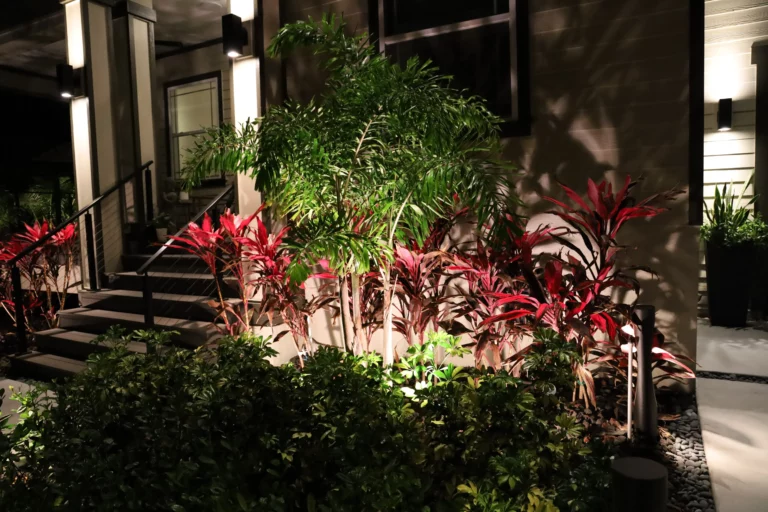
Architectural lighting shines onto your house or is directly attached to the facade, like a wall sconce. It can illuminate areas around your home or the home itself. This lighting can also be practical in that it lights up areas around your home to make it easier to see, and aesthetic in that it illuminates and highlights your home.
Architectural lighting attached to your home's facade is often hardwired, meaning you'll likely need someone to install and properly place the fixtures.
Picking a specific type of landscape light is an important part of the process, though it can be daunting. Let's break down all the options and what environments are best for each.
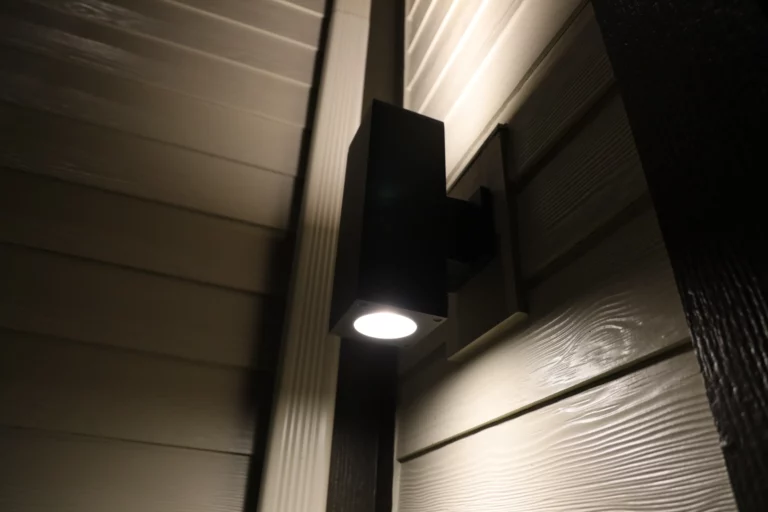
Spotlights in landscape lighting are similar to spotlights on a stage; they shine in one direction and showcase a particular object, like a tree. You can also use multiple spotlights on one thing to get an even better look. Spotlights also include downlights and bullet lights.
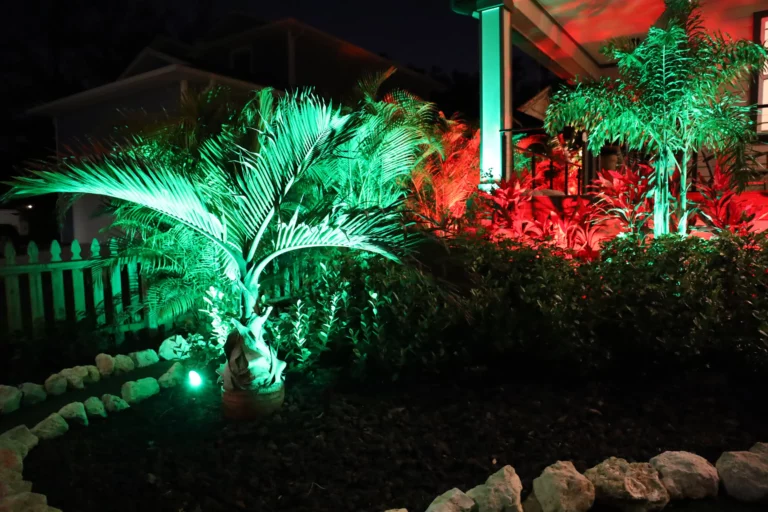
Floodlights are similar to spotlights in that they're directional, but they're better for security than highlighting an element of your property if attached to a smart lighting system. They light up a wider area and are often brighter, making seeing more of your yard or driveway easier.
Path lights are exactly what they sound like – they line the pathways around your home. The light is aimed downward and slightly out to focus on the ground.
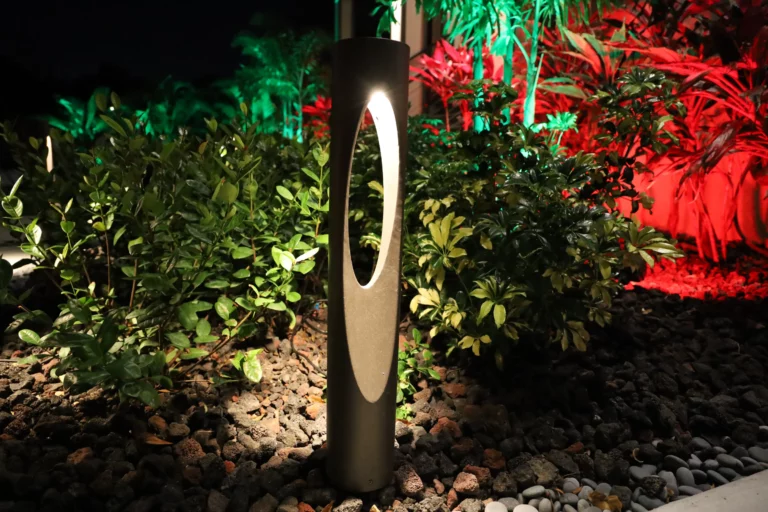
Think of bollard lights as torches – they're a post with a light at the top, shining in all directions. You can use them along paths similar to path lights, like the photo above.
Well lights are somewhat like water wells – they're in-ground, their light aimed upward to highlight plants or architecture. Because they're in-ground, they can be placed where you want inconspicuous lighting.
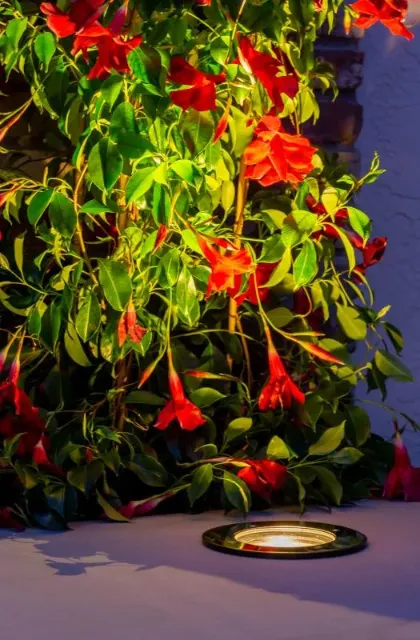
Wall wash lights also have a wide aperture like floodlights, but they're aimed against a wall – washing it with light. Since they can be aimed against walls with windows, you should be mindful of placement. You don't want lights reflecting into rooms you'd prefer to keep out of the limelight.
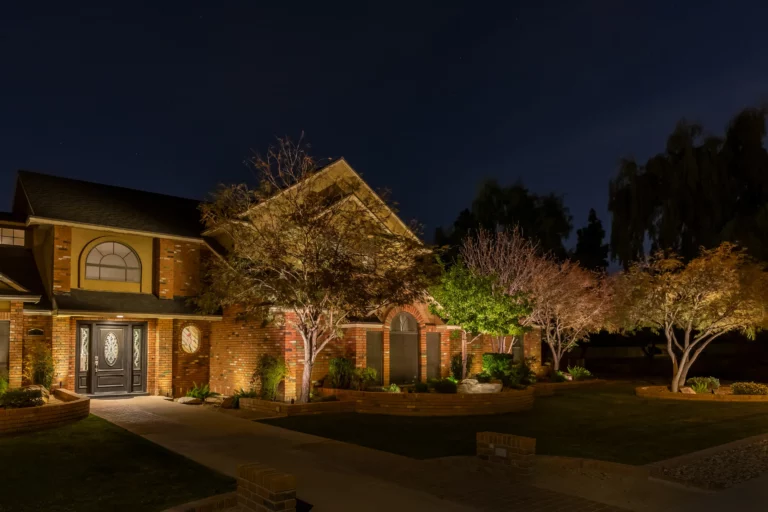
Sconce lights are fixtures mounted to walls, which can come in various styles, sizes, and strengths. Outside, they can be mounted to light up a patio or backyard. Commonly, they're placed on columns.
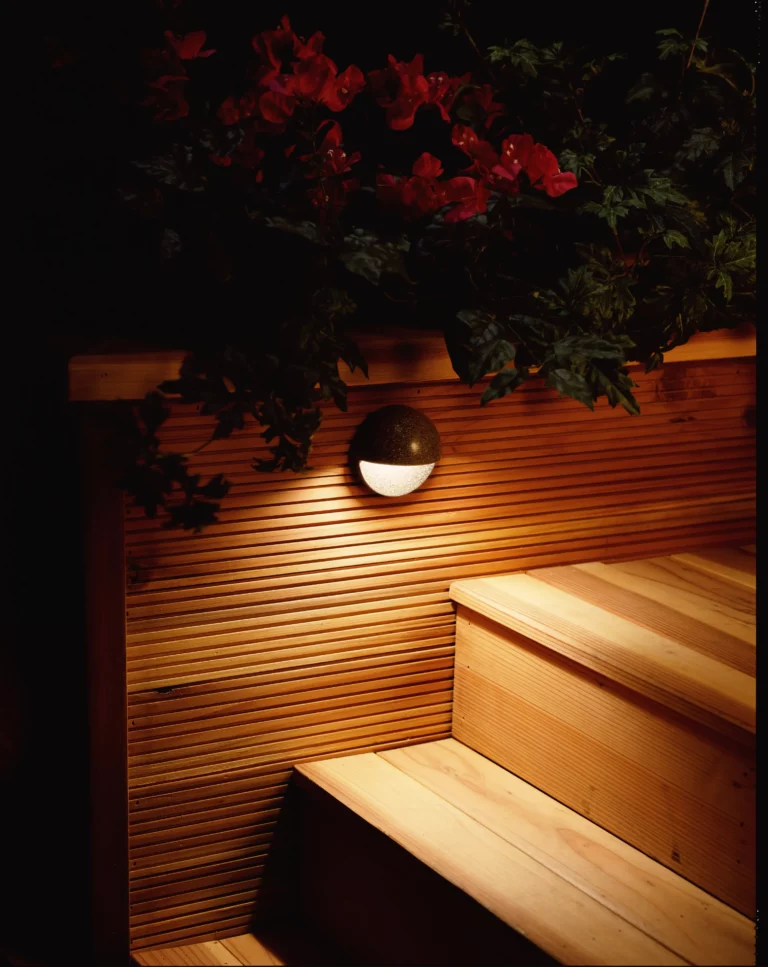
Landscape lighting is powered in two ways: solar or hardwired. Each type of lighting can be a good fit, depending on your needs. Let's discuss the pros and cons.
Small solar panels power solar landscape lighting, which charges its battery during the day with light and uses it in the evening once the sun goes down.
Solar outdoor lighting is very accessible, with big box stores like Lowe's or Home Depot selling them at affordable prices. You can also control them with an app or smart home technology.
Solar technology is also green, which saves you money and helps out the environment.
Lastly, they’re easy to install on your own. You just need to follow the directions that come with the light. Often, it’s as simple as putting the light into the ground with a stake.
But along with their convenience comes downsides. Because they're inexpensive, they can be less durable and might not last as long as hardwired options depending on the environment. The solar panel also might not receive as much energy from the sun as you need for consistent brightness and power. This is especially true in climates that may not get much sun.
Hardwired landscape lighting connects to your home's power source through low-voltage wiring, usually installed underground.
Since hardwired lighting connects to your home's power source, you won't have to worry about any fluctuations in your lighting's strength and power. It also stays put since the wiring is underground. Given that landscape lighting is usually placed in areas where people entertain, you won't have to worry about your kids or pets meddling with something they shouldn't.
However, installation is much more involved and will involve coordinating help from professionals. Since it’s a multi-step process, let’s walk through what professional landscape lighting installation looks like.
Having landscape lighting installed has several stages:
Your installer will look at the area where you'd like your lights, particularly where the outlets are on the outside of the house. If you don't have connections, you may need to have some installed by a licensed electrician at an extra cost.
Your installation team will need to dig trenches to lay specialized wire underground. Depending on where you'd like your lights, you may even need to dig underneath the pavement or concrete. However, the mess this step creates is only temporary.
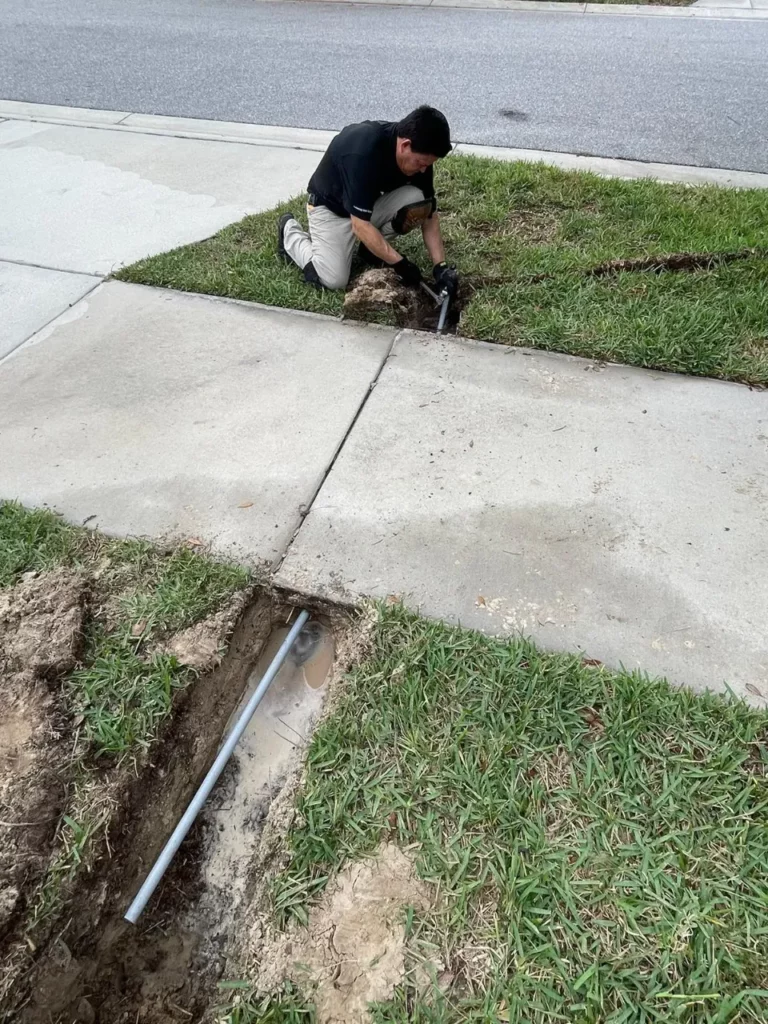
If you’re laying wires underground, the installer will put specialized wire, called direct burial wire, into the trenches to connect to your home’s power supply. This wiring is resistant to fluctuations in temperature and weather, so you don’t have to worry about it shorting out.
If you need wiring alongside your house, the professionals will use thin PVC pipe to create a neater appearance.
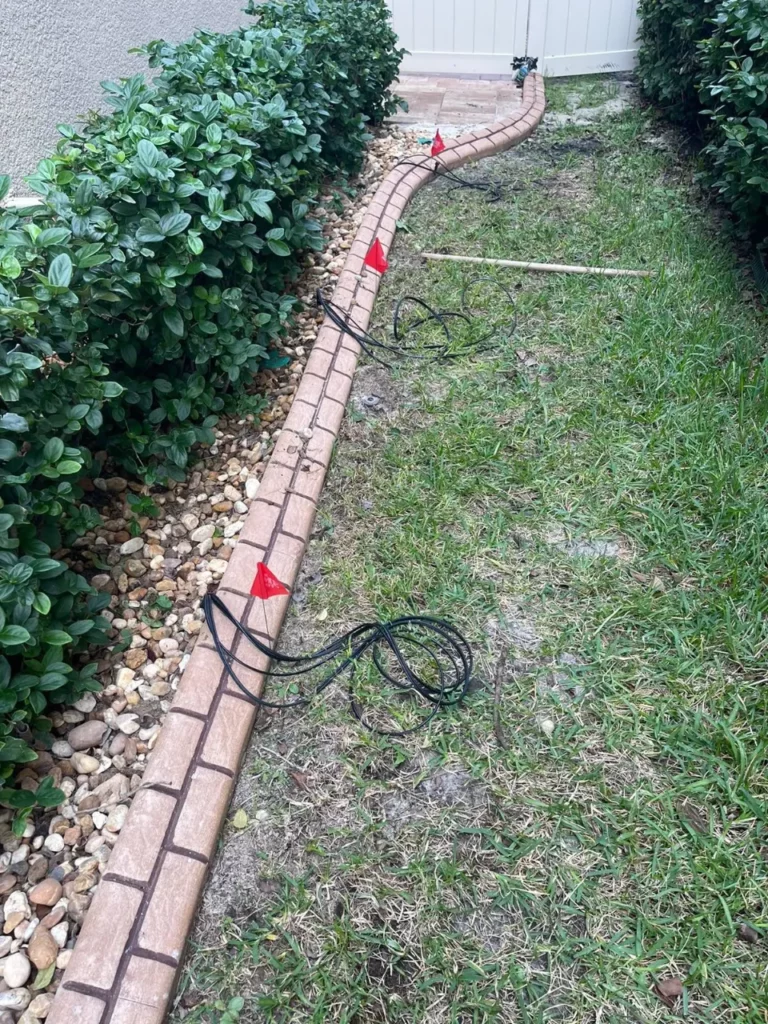
Making your home more beautiful can benefit you if you want to put it up on the market. It's an extra that a prospective buyer might have yet to consider before looking for a new home. However, it's something that adds value to your home.
The practical applications of landscape lighting are the most obvious reason most people get them. There’s no point in having a beautiful patio or pool if you can’t use them once the sun goes down.
Having lighting near your door prevents that awkward juggling act you sometimes have to do when trying to pull out your keys at night in the dark. If you have smart lighting, you can set it to turn on when you pull up to your house, so you won't have to worry about that at all.
Landscape lights can also make it safer to walk dark paths or light up areas that might cause injury. For instance, it’s easier to put down a path light next to an area where you could trip over a big root than uproot the entire tree.
Most people think of cameras or glass break sensors when they think of security. But a simple light can do wonders to deter crime, especially in conjunction with other security tools.
Having a light on makes dark or remote areas feel safer. They’re especially helpful in areas that could draw lurkers, like dark alleys.
If you make your lights smart with a sensor or a timer, you can have them turn on if someone comes close. Outdoor lights can help protect your home while you’re away; using outdoor lights to mimic how you’d naturally use them will make potential burglars believe you’re home, making them move onto an easier target.
Outdoor lighting’s value goes beyond making it possible to see outside in the dark. Landscape lighting can improve:
Let’s take a closer look at each, plus some examples.
Everyone can see that your home is gorgeous during the day, but what about at night? Landscape lighting can illuminate your home strategically to highlight whatever you'd like to feature.
Well-placed landscape lighting can also make your space look more luxurious by playing up high-end features.
Not only can you light up your home on regular days, but you can use colorful landscape lighting for holidays or parties. Turning your lights from a soft white to green and red around the holidays is an easy, fast way to make the outside of your home festive.
They can also create a mood for whatever you’re doing in your outdoor space. Lower, warmer lighting can make date nights on the patio more romantic, or colorful, flashing lights can energize a party.
Making your home more beautiful can benefit you if you want to put it up on the market. It's an extra that a prospective buyer might have yet to consider before looking for a new home. However, it's something that adds value to your home.
The practical applications of landscape lighting are the most obvious reason most people get them. There’s no point in having a beautiful patio or pool if you can’t use them once the sun goes down.
Having lighting near your door prevents that awkward juggling act you sometimes have to do when trying to pull out your keys at night in the dark. If you have smart lighting, you can set it to turn on when you pull up to your house, so you won't have to worry about that at all.
Landscape lights can also make it safer to walk dark paths or light up areas that might cause injury. For instance, it’s easier to put down a path light next to an area where you could trip over a big root than uproot the entire tree.
Most people think of cameras or glass break sensors when they think of security. But a simple light can do wonders to deter crime, especially in conjunction with other security tools.
Having a light on makes dark or remote areas feel safer. They’re especially helpful in areas that could draw lurkers, like dark alleys.
If you make your lights smart with a sensor or a timer, you can have them turn on if someone comes close. Outdoor lights can help protect your home while you’re away; using outdoor lights to mimic how you’d naturally use them will make potential burglars believe you’re home, making them move onto an easier target.
Outdoor lighting’s value goes beyond making it possible to see outside in the dark. Landscape lighting can improve:
Let’s take a closer look at each, plus some examples.
Everyone can see that your home is gorgeous during the day, but what about at night? Landscape lighting can illuminate your home strategically to highlight whatever you'd like to feature.
Well-placed landscape lighting can also make your space look more luxurious by playing up high-end features.
Not only can you light up your home on regular days, but you can use colorful landscape lighting for holidays or parties. Turning your lights from a soft white to green and red around the holidays is an easy, fast way to make the outside of your home festive.
They can also create a mood for whatever you’re doing in your outdoor space. Lower, warmer lighting can make date nights on the patio more romantic, or colorful, flashing lights can energize a party.
Landscape lighting can be made smart just the way door locks or security systems can – they can be programmed through a centralized hub so you can operate them without needing to flip on a light switch.
Since outdoor lighting is often used in spaces where people entertain, it’s particularly well-suited to remote or app control; you won’t have to step away from friends and family to adjust your lights. You can program the lights around your pool to come on at dusk so you won’t have to get off your pool float or brighten the area without leaving your spot at the grill.
Smart landscape lights can be controlled just like smart indoor lights, with three different methods:
We have apps for everything these days, lighting control included. Not only can you use your app to program your lights to come off and on at specific times, but you can turn them on from wherever you are.
Voice control is an even easier option. All you’ll need to do is integrate your lighting with a control system to operate your lights with a simple command.
Motion sensors might be the most hands-off of the smart lighting control options. A sensor can detect movements in a space, and if there isn't any motion within a specific span of time, the lights can turn off. For example, you can turn on a flood light above your back door when you approach it and have it turn off after a few minutes of inactivity.
The options for lighting control systems grow every year, but a few players dominate the home automation system space. We can split the ways you can control your smart lighting into two categories: voice-activated and lighting controls.
Voice-activated control is exactly what it sounds like – it’s lighting you can control with voice commands. Lighting controls are remote controls, panels, or apps that you use to program or control your lighting.
Sometimes the two can be integrated together, so they’re not mutually exclusive.
Josh AI is one of the most advanced voice-controlled home automation systems available. It operates using natural speech commands, just as you'd talk to another person. For instance, you can say, "Josh, turn off the lights in the dining room" rather than "turn off the dining room lights." You can also give it multiple commands at once.
Given the power of AI like this, it’s natural to have concerns about privacy. Josh AI has easy-to-understand privacy settings, where you can easily control what Josh hears and responds to with the tap of a button.
It's a natural fit for outdoor spaces. All you'll have to do is say, "Josh, turn on the lights on the lanai," and it'll come on. It can also integrate seamlessly with other remote control or app-based systems like the ones we'll get into below.
Amazon’s Alexa technology is probably very familiar to most. Amazon offers a full range of products, from Amazon Echo to thermostats, all of which are naturally compatible with each other.
With the breadth of what Amazon offers, Alexa is a natural choice for many people who want to make their home smart. You can use it to control your home theater lights one moment and turn around to ask Alexa to purchase more popcorn the next. However, unlike Josh AI, you can only give one command at a time, which may feel unnatural to some.
It’s also very accessible, with millions already using the platform. Amazon Prime has an estimated two-hundred million members, so many may feel more comfortable making the leap into smart home technology with a familiar brand.
Google is similar to Amazon in that they have a range of interconnected products in every area of home automation. Also, like Amazon, it's a familiar brand.
Google is also backed by its wealth of knowledge and its strong language recognition abilities. However, it has fewer device integrations than Alexa does and can also only handle one command at a time.
But luckily, it works with landscape lighting. If your desired system aligns with Google’s capabilities, it could be a great fit.
Control4 gets rid of a common issue that people have with smart home technology by uniting different systems under one user-friendly control system. It’s simple to use and so intuitive that any member of your family or guest will be able to use it easily.
It also encompasses all areas of home automation, from home security to lighting to home theaters, and more.
Lutron is a pioneer in the lighting control world. The company shines over its competitors in its wireless control; instead of using a ZigBee protocol like its competitors, it uses a
Vitrea is one of the newest options on the market. They have a similar level of functionality and user-friendliness to Lutron and Control4, but it's one of the most aesthetically pleasing options on the market.
The options in this aspect of choosing your landscape lighting are some of the most important and complicated of them all. Here are a few guiding questions:
However, it’s important to note that not all systems integrate with all brands of lighting. Here’s where having a professional could help you integrate all of your devices. As we’ll get into in the next section, sometimes doing it yourself can lead to problems that you’ll need a professional to solve.
You might be someone who loves a good weekend project. And now that you know how much your home could benefit from landscape lighting, you might want to head over to Home Depot to get started.
But should you DIY your landscape lighting? It really depends on your situation. Obviously, if you’re an electrician with years of experience under your belt, installing hardwired lighting will be a breeze with a few extra sets of hands. However, if you don’t have many tools and you’re unsure about pulling off the project the way you imagined, a professional might be a better fit.
Let’s break it down further.
If you’re going with solar lighting, doing it yourself is simple. All you need to do is figure out where you want to place them and follow the directions included with the lights. As we said before, solar lighting is a great option if you’d like something done quickly, and DIYing it is a good way to get it done on your schedule.
As we said above, if you're experienced or even licensed to work with electrical wiring, you could probably handle hardwiring your landscape lights on your own if you have several extra pairs of hands to help you with the significant labor involved.
DIY landscape lighting is a good fit for people who:
Assuming you aren’t going with solar lighting, most people fall into this category. Most people don’t have the technical knowledge and ability to plan and install hardwired landscape lighting.
And for safety reasons, they shouldn’t. Between the wiring, trenching, and other potential pitfalls of installation, it’s a lot for most people to take on and successfully finish. Installation has a lot of nuances that pros navigate well.
Hiring a professional is a good fit for people who:
The good thing about landscape lighting is that when installed properly, it shouldn’t cause many problems. But as with anything, there’s always a chance that something could go wrong. Here are the most common problems we see when it comes to installing and enjoying landscape lighting:
This problem is exclusive to hardwired landscape lighting, as solar lighting just requires putting a stake into the ground.
Because hardwiring requires digging trenches, an installer may encounter an obstacle as they dig that trench. Common ones are concrete or tree roots. This may add extra time or even prohibit the lighting design you want.
Typically this can be spotted before a project begins, but sometimes it can be an unexpected delay or cost.
If installed by a professional, you shouldn’t have problems with your wiring and power. Assuming you’ve done your research to pick the best professional for the job, they’ll be able to complete your project perfectly.
However, if you’ve chosen to go the DIY route, you can run into numerous problems that prevent you from actually using your landscape lighting as you intended.
As a worst-case scenario, you could seriously injure yourself or someone else. While low-voltage lighting is generally safe, improperly buried or connected wiring can create issues that could cause a fire.
On a slightly less dangerous note, you could just connect the lighting improperly, resulting in inconsistent power. Solar lighting might not gather enough power to have your lights shine brightly or at all. Or you could end up getting into the project and realize you're in over your head, leading you to call a pro anyway.
Even in places with relatively stable and consistent weather, landscape lighting is exposed to the elements – fluctuations in temperature, humidity, storms, and more.
Thankfully, landscape lighting companies are well aware of this and have created lights that withstand the elements. However, they’re mostly weatherproof against water or sunlight shining on them, not being submerged in water. If you live in an area that experiences flooding, then your lighting could be damaged. And if you’ve gone with solar lighting, they can be swept away, especially if you’re already spending a lot on professional installation. But you get what you pay for, and investing in a high-quality system can save you money in the long run.
Picking the perfect light fixture is an important part of landscape lighting. Luckily, it’s something that can fit into any budget. You can choose an expensive, custom-made light fixture or a great bargain at your favorite store.
Fixtures that look the way you want them to and fit within your price range are almost guaranteed to be available somewhere.
If you're struggling to figure out how much to spend or don't want to go way over budget, review the factors above, along with the six factors to consider when choosing landscape lighting and your finances.
Landscape lighting is accessible in many price ranges, so taking the time to make a budget that you can stick to can make the project even more worthwhile.
Now you have a solid overview of landscape lighting and you might want to get started with your own home. If you’re a DIY enthusiast, starting with what you need and where you’d like to place your lighting is a great start. From there, deciding to choose hardwired or solar will determine your next course of action.
Hiring a professional might be your preferred route. In that case, here are a few questions to ask before hiring a landscape lighting designer.
If you'd like a more step-by-step guide to what you need to pick your landscape lighting, you can download our Guide to Choosing Landscape Lighting worksheet here.
If you’d like to know more about how Hive can help you with your landscape lights, you can check out our service page or contact us here to set up a free consultation. We’re also available for any other smart home needs you may have.


